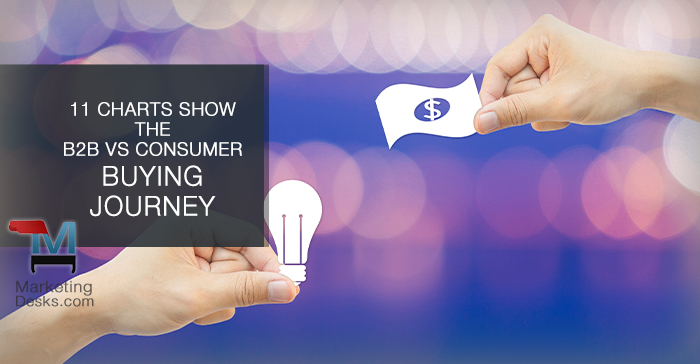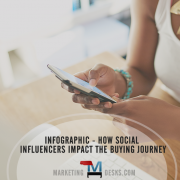11 Charts Compare B2B Buyer and Consumer Buying Journey
Consumer, B2B Buyer Shopping Behaviors and How Today’s Marketers are Reaching Them
As the eleven charts (and one content marketing slideshare) below clearly show, there simply isn’t one single best marketing channel, strategy or device today’s marketers need to master when it comes to reaching buyers, whether B2B buyer or consumer. You need to be be ready to use them all.
There’s No Such Thing as a “Most Important” Marketing Channel to Reach the B2B Buyer
“Seventy-six percent of B2B survey respondents said they use three or more channels to interact with a brand before making a purchase decision, and 26% of B2B respondents said they use five or more channels.” (CustomerThink.com, B2B Buyers Prefer Cold, Hard Facts)
With that said, according to ThinkWithGoogle.com, most B2B buyers, like consumers, start their buying journey with online search:
- 89% of B2B buyers use online searching during the journey
- 71% of B2B buyers start researching with a generic online search
- 12 – The average number of online searches a B2B buyer does before engaging on a specific brand’s site
With 60 percent of the B2B buying journey complete before the B2B buyer ever reaches out to a sales person or brand representative, it’s never been more critical for marketers to successfully get found in generic and branded online searches. And once found, their content must do the work of differentiating the brand and its products in order to get the sale.

Source: ThinkwithGoogle.com
For consumers, it’s a much different story as explained by Search Engine Watch. Though online search is one of the first things a shopper will do in order to research products, in 2016 most of those consumer searches started not with a generic search, but on Amazon.com:
- 55% – product searches started on Amazon.com in 2016
- 28% – product searches started in search engines in 2016
- 16% – product searches started on retail websites in 2016
in 2015
- 44% – product searches started on Amazon.com in 2016
- 34% – product searches started in search engines in 2016
- 21% – product searches started on retail websites in 2016
And 90% of consumers will check Amazon even if they’ve found their product elsewhere – 78% do this often or always.

Source: Blue Nile Research
B2C buyers (consumers) use these channels before making a purchase:
- 82% – Online search
- 79% – Brand website
- 79% – Customer reviews and case studies
- 22% – Blog posts
- 19% – Social media
- 15% – Mobile
By comparison, the shopping behaviors of the typical B2B buyer is very similar except when it comes to customer reviews, where B2B buyers are much less likely to seek out customer reviews before making a purchasing decision:
- 82% – Online search
- 80% – Brand website
- 54% – Customer reviews and case studies
- 25% – Blog posts
- 20% – Social media
- 14% – Mobile

Source: Blue Nile Research
Likewise, the number of channels a B2B buyer is likely to use is similar to those of the typical consumer buying journey. Number of brands B2C (Consumers) interacted with a brand before making a purchasing decision:
- 35% – interacted with 3 brands
- 25% – interacted with 5 or more brands
- 23% – interacted with 2 brands
- 12% – interacted with 4 brands
- 7% – interacted with only one brand
When it came to B2B buyers, the survey found that B2B buyers are people too, and their behavior remains fairly consistent whether buying for themselves personally or on behalf of a business:
- 36% – interacted with 3 brands
- 26% – interacted with 5 or more brands
- 16% – interacted with 2 brands
- 14% – interacted with 4 brands
- 8% – interacted with only one brand

Source: Blue Nile Research
What Type of Content Will Attract the B2B Buyer and Consumer Online?
The content that will generate a click from consumers vs. B2B buyers searching online is a mixed bag, with similarities as well as differences in the five types of content people said would cause them to take action. When searching online, consumers said they were most likely to click on:
- 45% – Data and statistics
- 30% – Blog posts
- 11% – Videos
- 9% – Infographics
- 6% – Images
Whereas B2B buyers said they would be most likely to click on the following when searching for something online:
- 46% – Data and statistics
- 18% – Blog posts
- 18% – Videos
- 10% – Infographics
- 8% – Images

Source: Blue Nile Research
Content Marketing Plays a Vital Role for the Consumer and the B2B Buyer
Online content is crucial for both B2C and B2B buyer discovery, as well as moving prospects through the buying journey. This Content Marketing Institute SlideShare lists the top ways B2B content marketers delivered content for discovery and buyer cultivation online in 2016:
- 93% – Social media content (other than blogs)
- 82% – Case studies
- 81% – Blogs
- 81% – E-Newsletters
- 81% – In-person events
- 79% – Articles on brand website
- 79% – Videos
- 76% – Illustrations and photos
- 71% – White papers
- 67% – Infographics
- 66% – Webinars and webcasts
- 65% – Online presentations
When rating the effectiveness of tools used for content marketing, B2B marketers said this:
- 75% – In-person events
- 66% – Webinars and webcasts
- 65% – Case studies
- 63% – White papers
- 62% – Videos
- 61% – Research reports
- 60% – E-Newsletters
- 59% – Blogs
- 58% – Infographics
- 58% – Online presentations

Source: Content Marketing Instititute (CMI) SlideShare
In all reality, it appears there are only minor differences in the way B2C marketers are using online content to reach and engage prospects as compared to those marketing to B2B buyers:
B2C
- 76% – Use content marketing
- 38% – Think their company uses content effectively
- 37% – Describes their company’s content marketing as sophisticated/mature
- 48% – Meet daily or weekly to strategize
- 37% – Have a documented content strategy
- 12 – Average number of tactics used
- 7 – Average number of social platforms used
- 4 – Average number of paid ad methods used
- 32% – Percent of budget allocated to content marketing
- 50% – Plan to increase budget over the next year
B2B
- 88% – Use content marketing
- 30% – Think their company uses content effectively
- 32% – Describes their company’s content marketing as sophisticated/mature
- 44% – Meet daily or weekly to strategize
- 32% – Have a documented content strategy
- 13 – Average number of tactics used
- 6 – Average number of social platforms used
- 3 – Average number of paid ad methods used
- 28% – Percent of budget allocated to content marketing
- 51% – Plan to increase budget over the next year


Source: CMI SlideShare
When it comes to sharing content, B2B marketers share most often on these social networks (and their rated effectiveness):

Source: CMI SlideShare
The B2B Buyer is Catching up with Consumer Use of Mobile in the Buying Journey
It’s not a mobile first world, it’s a buyer-first world. The B2B buyer is nearly as likely to use mobile devices, including smartphones, in the course of researching and buying products. Likewise, it’s important to remember that the consumer may be using more than one type of device, and that both types of buyers are ready, willing and able to use their smartphones while shopping in your showroom or brick-and-mortar store.
When it comes to the B2B buyer, ThinkwithGoogle.com notes they are using mobile devices on an exponentially-increasing basis on as well as off the job site:
- 42% used a smartphone during the journey (91% growth over two years)
- 49% used smartphones for product research while at work to compare prices, read about products, compare features and contact sellers
- B2B purchasing on smartphones is up 22% over the past 2 years

Source: ThinkwithGoogle.com
As we’ve already noted, consumers often start their online search on Amazon, more often than they do on search engines. The same holds true for the mobile shopper, according to Search Engine Watch:
- 50% of mobile shoppers try Amazon first
- 34% try search engines first
- 16% try other retail sites first
- 76% of consumers shop via smartphone, 90% have made a purchase on a smartphone
- 50% of consumers shop via smartphone at least once a week
- 92% say smartphone shopping can influence purchase decisions, 52% say it often or always supports a purchase
- 88% use smartphones to assist shopping while in brick and mortar stores
- 78% have a retailer’s mobile app, 82% of these have non-Amazon apps

Source: Search Engine Watch
***
If you’d like to partner with content writers who understand how today’s B2B buyer and consumers find, research and engage with brands online, we’re ready to help. Reach out to us with your question or request a quote for your next project – we would love to be part of your story.
- Search-optimized web content copywriting
- Search-optimized blog content, LinkedIn post writing and ghostwriting
- Ad and marketing collateral copy
[contact-form to=’all3@marketingdesks.com’ subject=’web form – content marketing request’][contact-field label=’Name’ type=’name’ required=’1’/][contact-field label=’Email’ type=’email’ required=’1’/][contact-field label=’Best number to reach you’ type=’text’/][contact-field label=’Website’ type=’url’/][contact-field label=’How can we help?’ type=’textarea’ required=’1’/][/contact-form]









Trackbacks & Pingbacks
[…] Before they even reached your website or subscribed to your email list, they’ve already completed 60% of their journey on social media […]
[…] point during the buying journey offers unique opportunities where your business can engage the customer. Make sure you’re making […]
Leave a Reply
Want to join the discussion?Feel free to contribute!